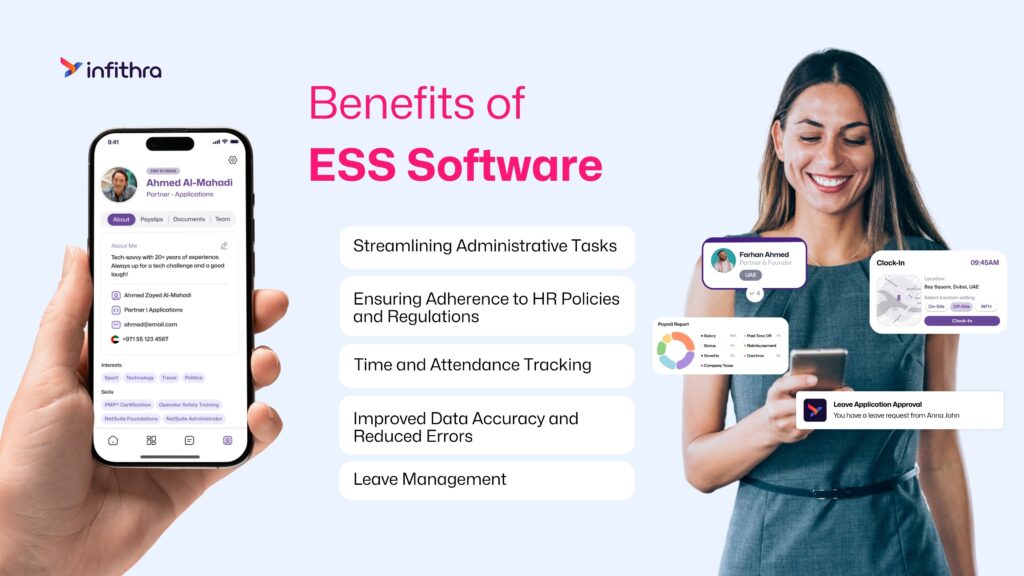In the past, the HR landscape relied on manual processes, imposing a significant workload on departments with routine administrative responsibilities such as leave tracking and time-off management. However, the nature of HR roles has significantly changed, especially for larger companies handling a much larger workforce. This change has made it necessary to embrace more advanced HR technology to overcome the limitations of traditional HR systems.
We live in a society that values independence in various aspects. From booking travel online to troubleshooting our gadgets, we’ve embraced the idea of handling tasks ourselves in real time. The same goes for the employee self-service options in the work setting. It’s becoming more evident that companies without self-service for employees are lagging behind in some aspects. Imagine needing to update your personal information, but it turns into a hassle. You have to go through several people, send emails, and chase HR just to get it done. Employees increasingly seek efficiency and the ability to manage their work details independently, making the need for more user-friendly and accessible systems apparent.
These traditional work processes are often lengthy and time-consuming, leading employees to desire more control over their own tasks and HR-related responsibilities. It’s not surprising that they feel a sense of disconnection. The growing expectation for autonomy and streamlined procedures is a natural response to the cumbersome nature of standard practices.
What is Employee Self-Service (ESS)?

Employee Self-Service, exactly as its name suggests, is a contemporary approach in human resource management. It grants employees a measure of control over administrative tasks relating to their personal information management. In simpler terms, ESS empowers employees to manage their basic tasks, such as modifying personal details, managing leave, etc., just through the app. This becomes effortless when your company’s HRMS facilitates ESS workflows!
ESS Features May Encompass Enabling Employees To:
- Modify their contact information.
- Revise their banking details.
- Review their payslips or employee benefits.
- Request leaves or time off.
- Lodge expense claims.
- Check the weekly/monthly shift schedule.
- View profiles of fellow colleagues.
- Explore immediate team structure and reporting lines.
- Access a comprehensive overview of their absence history and leave balance.
- Stay informed about key business announcements.
- Receive timely reminders to participate in polls and surveys.
- Get alerts for expiring documents to ensure timely renewal.
- Receive notifications for team celebrations, including birthdays, anniversaries, new starters, etc.
How Can ESS Portals Benefit HR Teams

Streamlining Administrative Tasks:
- ESS portals allow employees to handle repetitive administrative tasks,suchas updating personal information, submitting documents, and managing employment details, without the need for direct intervention from HR personnel.
- It benefits organizational processes by streamlining the workflow by providing a centralized, user-friendly platform for employees to access and update their information independently. This will reduce the burden on HR teams and improve overall efficiency.
- Managers can monitor employee working hours efficiently by implementing a system that integrates with biometric devices. This integration ensures accurate tracking of attendance data, fostering transparency in recording hours worked, overtime, or absences. This streamlined process enhances communication and accountability between employers and employees.
- By implementing such workflow streamlines manual processes, reducing the administrative burden associated with tracking working hours. It also mitigates the risk of manual calculation errors.
- ESS facilitates the seamless request and approval of various types of leave. Employees can easily submit leave requests via the app, view their leave balances, and track the status of their requests in real-time.
- This feature enhances communication between employees and HR or line managers by streamlining the leave approval process. It ensures that HR or managers have real-time insights into the current working status and leave status of employees.
Improved Data Accuracy and Reduced Errors:
- By allowing employees to directly input and manage their information, ESS reduces the likelihood of any data entry errors. By leveraging cloud-based HR technology, businesses can maintain accurate and up-to-date employee records with enhanced efficiency and reliability.
- As businesses scale, the importance of having a unified tool for consolidating personal data becomes increasingly evident. The self-service aspect empowers employees to take ownership of their personal data, leading to improved data accuracy throughout the organization.
Enhanced Compliance with HR Policies and Regulations:
- ESS features often come with built-in compliance checks, guiding employees to adhere to regional HR policies and regulations when submitting information or requests they are entitled to.
- With a standardized and central platform fully configured to local regulations, ESS helps organizations maintain compliance with legal and internal company policies, reducing the risks of potential non-compliance and legal issues.
Steps to Deploying the ESS Portals Successfully
Assessment and Planning:
- Define Objectives: Clearly outline the goals and objectives of implementing the ESS portal across the organization. Understand what problems it aims to solve within the current system in place and what benefits it should bring.
- Conduct Needs Analysis: Analyze the requirements and preferences of the end-users with all your people. Consider factors such as accessibility, usability, and easy-to-use functionality to ensure the portal meets the needs of diverse users.
Selecting the Right ESS Portal Solution:
- Evaluate Options: Research and evaluate different ESS portal solutions available in the market. Consider factors such as features, scalability, security, and integration capabilities to other business tools.
- Customization: Choose a solution that allows for customization based on your organization’s unique requirements. The portal should align with your company’s branding with internal workflows and overall organization structure.
Integration with Existing Systems:
- Assess Compatibility: Ensure the ESS portal integrates seamlessly with your existing HR systems, databases, and other relevant applications. A system that leverages an OpenAPI enhances interoperability, making it easier to integrate the ESS portal seamlessly with your existing HR systems and other relevant applications.
- Data Security: Implement robust security measures to protect sensitive employee information collected by the organization. Key components for a secure ESS portal include encryption, multi-factor authentication, routine backups, built-in features for data recovery, and comprehensive data protection measures.
Testing and Deployment:
- User Acceptance Testing (UAT): Conduct thorough testing of the ESS portal with a group of representative end-users across the business. Address any issues or feedback with a focus group before moving to the deployment phase.
- Phased Rollout: Implement a phased rollout rather than deploying the ESS portal organization-wide at once. This approach allows for smoother transitions, easier issue identification, and better support for your end-users.
Once you’ve designed your self-service portal, consider the below steps to increase the adoption of your Employee Self-Service system.
Educate Users:
Provide training sessions, such as classes, one-on-one sessions, video tutorials, or user manuals to familiarize employees with the new system.
Gradual Transition:
Phase out the old processes slowly to avoid frustration. Offer training on key features of HR software to help employees ease into using the new tool.
Internal Marketing:
Create awareness through internal marketing efforts. Highlight the user-friendly aspects. Additionally, leverage polls, surveys, and team chat features to showcase that the system is not merely a tool for administrative tasks but also a platform for meaningful interaction. This approach ensures that employees not only appreciate the system’s practical aspects but also recognize its value as a collaborative and engaging workspace.
Conclusion
Enabling Employee Self-Service is a game-changer for busy HR teams. It serves as a centralized hub for crucial employee information, efficiently handling daily requests that would otherwise flood email inboxes.
By empowering employees to manage their personal information, leaves, and other administrative tasks independently, ESS portals contribute to a significant reduction in the burden on HR teams. The benefits extend beyond efficiency gains, encompassing improved data accuracy, enhanced compliance with HR policies, and transparent attendance tracking. This system is mutually beneficial, empowering employees with autonomy and providing a convenient method for them to update their details at their convenience. It’s a win-win solution.

Leave a Reply